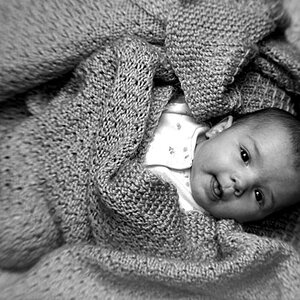amolitor
TPF Noob!
- Joined
- May 18, 2012
- Messages
- 6,320
- Reaction score
- 2,131
- Location
- Virginia
- Can others edit my Photos
- Photos OK to edit
The first time we see a picture, our eye moves over it picking things out, settling here and there, and so on.
This sets, I believe, a pattern. It is quite difficult to "re-see" a picture, the second time. We're going to tend to fixate on the things we noticed the first time, we're going to tend to move our eye across the image in a pattern set by that first experience of the image (not necessarily in the same way as that first time, but that first time will tend to set in stone what we "find interesting" about the picture, good or bad).
This has some consequences:
- you, as the photographer, know what you think is important. You will look at your photograph in a way that is informed by whatever idea you had taking the picture. This is probably quite different from the way a "cold" viewer will look at the picture. The main purpose for learning all this business of "leading lines" and whatnot is to develop some intellectual way to guess how that "cold" viewer is going to look at your picture,
- you probably shouldn't show unfinished work to people, especially if the "unfinished" part is important to experiencing the image. If the subject is muddy, if the relationships are confused, but you have ideas for how to clarify those, do that work before you show the image to anyone. If someone sees your photograph in the unfinished state, they are too likely to "see it wrong" and then they'll never be able to see it "right" even after you do the work. Even if the post work is successful, and does in fact make all clear, the people who saw it before will be unable to re-see the image the way you intend.
- your goal as a photographer, or other visual artist, is to try to arrange the image so that a viewer coming at it cold will see it in approximately the same way you do. If they see it in a different way, you might get lucky, but you're not in control and arguably you have failed. You may have made a fine image, but it's entirely by accident. If they physically see the image the same way you do, if their eye moves more or less as yours does, if they identify as important the same things you think are important, if they see the same relationships that you do, then there's a reasonable chance that they will feel the same emotional impact you do, and perhaps think the same sort of things you do. If not, it's anybody's guess, and largely random, how the viewer will feel and what the viewer will think, looking at your photograph.
This sets, I believe, a pattern. It is quite difficult to "re-see" a picture, the second time. We're going to tend to fixate on the things we noticed the first time, we're going to tend to move our eye across the image in a pattern set by that first experience of the image (not necessarily in the same way as that first time, but that first time will tend to set in stone what we "find interesting" about the picture, good or bad).
This has some consequences:
- you, as the photographer, know what you think is important. You will look at your photograph in a way that is informed by whatever idea you had taking the picture. This is probably quite different from the way a "cold" viewer will look at the picture. The main purpose for learning all this business of "leading lines" and whatnot is to develop some intellectual way to guess how that "cold" viewer is going to look at your picture,
- you probably shouldn't show unfinished work to people, especially if the "unfinished" part is important to experiencing the image. If the subject is muddy, if the relationships are confused, but you have ideas for how to clarify those, do that work before you show the image to anyone. If someone sees your photograph in the unfinished state, they are too likely to "see it wrong" and then they'll never be able to see it "right" even after you do the work. Even if the post work is successful, and does in fact make all clear, the people who saw it before will be unable to re-see the image the way you intend.
- your goal as a photographer, or other visual artist, is to try to arrange the image so that a viewer coming at it cold will see it in approximately the same way you do. If they see it in a different way, you might get lucky, but you're not in control and arguably you have failed. You may have made a fine image, but it's entirely by accident. If they physically see the image the same way you do, if their eye moves more or less as yours does, if they identify as important the same things you think are important, if they see the same relationships that you do, then there's a reasonable chance that they will feel the same emotional impact you do, and perhaps think the same sort of things you do. If not, it's anybody's guess, and largely random, how the viewer will feel and what the viewer will think, looking at your photograph.







![[No title]](/data/xfmg/thumbnail/39/39501-c3f6a664311b0a3868b613f963809fb1.jpg?1619739058)

![[No title]](/data/xfmg/thumbnail/36/36300-760519cb9a8ebbfc57cc3d1fda5dd37c.jpg?1619737494)

![[No title]](/data/xfmg/thumbnail/35/35212-039632ef3763350189fc49390cb7eadf.jpg?1619736950)

